You searched for: Memorial%20University%20of%20Newfoundland%EF%BF%BD%EF%BF%BD%EF%BF%BD%EF%BF%BD%EF%BF%BD%EF%BF%BD%EF%BF%BD%EF%BF%BD%EF%BF%BD%EF%BF%BD%EF%BF%BD%EF%BF%BD%EF%BF%BD%EF%BF%BD%EF%BF%BD%EF%BF%BD%EF%BF%BD%EF%BF%BD%EF%BF%BD%EF%BF%BD%EF%BF%BD%EF%BF%BD%EF%BF%BD%EF%BF%BDWeChat%EF%BF%BD%EF%BF%BD%EF%BF%BDKAA2238%EF%BF%BD%EF%BF%BD%EF%BF%BDOEA2Lj
<< Previous | Displaying results 151-175 of 338 for "Memorial%20University%20of%20Newfoundland%EF%BF%BD%EF%BF%BD%EF%BF%BD%EF%BF%BD%EF%BF%BD%EF%BF%BD%EF%BF%BD%EF%BF%BD%EF%BF%BD%EF%BF%BD%EF%BF%BD%EF%BF%BD%EF%BF%BD%EF%BF%BD%EF%BF%BD%EF%BF%BD%EF%BF%BD%EF%BF%BD%EF%BF%BD%EF%BF%BD%EF%BF%BD%EF%BF%BD%EF%BF%BD%EF%BF%BDWeChat%EF%BF%BD%EF%BF%BD%EF%BF%BDKAA2238%EF%BF%BD%EF%BF%BD%EF%BF%BDOEA2Lj" | Next >>
-
Flag graphic for US 6th Armored Division
PhotoA digital representation of the United States 6th Armored Division's flag. The US 6th Armored Division is also known as the "Super Sixth." During World War II, they were involved in the Battle of the Bulge and overran the Buchenwald concentration camp. The 6th Armored Division was recognized as a liberating unit in 1985 by the United States Army Center of Military History and the United States Holocaust Memorial Museum (USHMM).

-
Flight and Rescue
SeriesExplore the story of over 2,000 Polish Jewish refugees who fled east to escape war-torn Europe. They sought safety in such distant places as China and Japan.
-
Life After the Holocaust: Blanka Rothschild
ArticleAfter WWII and the fall of the Nazi regime, Holocaust survivors faced the daunting task of rebuilding their lives. Listen to Blanka Rothschild's story.
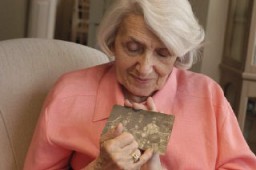
-
Recipes recorded in a forced-labor camp
Media EssayThe documentation of treasured recipes evokes memories of happier times and bears witness to the will to create under the most dire of circumstances. In some cases, this type of documentation was even a way to preserve a past that the Nazis and th...
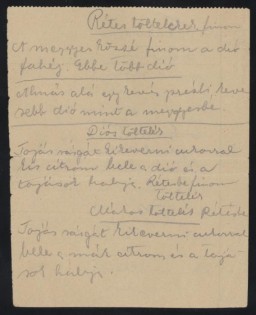
-
Hoess affidavit
ArtifactAffidavit signed by Rudolf Hoess attesting to the gassing of Jews while he was the commandant of the Auschwitz killing center. The German text reads: "I declare herewith under oath that in the years 1941 to 1943 during my tenure in office as commandant of Auschwitz Concentration Camp 2 million Jews were put to death by gassing and a 1/2 million by other means. Rudolf Hoess. May 14, 1946." The confession is also signed by Josef Maier of the US Chief of Counsel's office. A photoreproduction of the original…
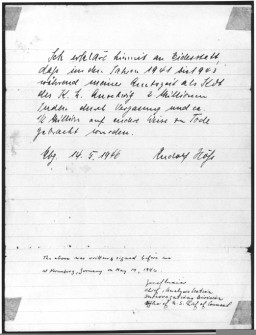
-
Armenian deportees
PhotoA small group of Armenian deportees walking through the Taurus Mountain region, carrying bundles. A woman in the foreground carries a child. Ottoman Empire, ca. November 1915. Photograph taken by Armin T. Wegner. Wegner served as a nurse with the German Sanitary Corps. In 1915 and 1916, Wegner traveled throughout the Ottoman Empire and documented atrocities carried out against the Armenians. [Courtesy of Sybil Stevens (daughter of Armin T. Wegner). Wegner Collection, Deutsches Literaturarchiv, Marbach…

-
Miles Lerman describes the value of weapons
Oral HistoryMiles Lerman was a Holocaust survivor, partisan fighter in the forests of Poland, international leader in the cause of Holocaust remembrance, and a "founding father" of the United States Holocaust Memorial Museum.

-
Siege (1940)
ArticleJulien Bryan’s ten-minute film Siege, first non-Nazi produced footage of the start of WWII, records horror and chaos in Warsaw following the German invasion.

-
Writers and Poets in the Ghettos
ArticleSongs, verses, and writings of writers and poets in the ghettos reflect efforts to preserve culture, humanity, and documentation, as well as acts of defiance. Explore examples.
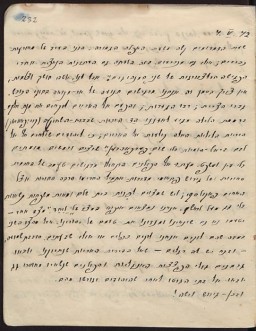
-
Wöbbelin
ArticleThe US 8th Infantry and the 82nd Airborne Divisions arrived at the Wöbbelin camp in May 1945, witnessing the deplorable living conditions in this subcamp of the Neuengamme concentration camp.

-
David Broudo
ArticleRead the Jewish Partisan Educational Foundation's short biography of David Broudo.

-
View of a burial site in Nyanza, Rwanda
PhotoNyanza is a site near Kigali, Rwanda, where several thousand people were executed after being marched from the Belgian Technical School in April 1994. At the school, they had been under the protection of UN peacekeepers until the soldiers were recalled to the airport to help evacuate expatriates. This is one of the few sites where victims had the honor of individual burial; most often they were buried together in large graves. Photograph taken on November 24, 2007. United States Holocaust Memorial Museum

-
Flag graphic for the US 101st Airborne Division
PhotoA digital representation of the United States 101st Airborne Division's flag. The US 101st Airborne Division (the "Screaming Eagles" division) was established in 1942. During World War II, they were involved in D-Day and the Battle of the Bulge. The division also captured the city of Eindhoven and uncovered the Kaufering IV camp. The 101st Airborne Division was recognized as a liberating unit in 1988 by the United States Army Center of Military History and the United States Holocaust Memorial Museum…

-
Flag graphic for US 103rd Infantry Division
PhotoA digital representation of the United States 103rd Infantry Division flag. The US 103rd Infantry Division (the "Cactus" division) was established in 1942. During World War II, they were involved in the Battle of the Bulge and captured the city of Innsbruck. The division also uncovered a Nazi subcamp attached to Kaufering camp complex. The 103rd Infantry Division was recognized as a liberating unit in 1985 by the US Army's Center of Military History and the United States Holocaust Memorial Museum…

-
Flag graphic for US 104th Infantry Division
PhotoA digital representation of the United States 104th Infantry Division's flag. The US 104th Infantry Division (the "Timberwolf" division) was activated in 1942. During World War II, they captured the cities of Cologne and Halle. The division also overran Nordhausen and the Dora-Mittelbau concentration camp. The 104th Infantry Division was recognized as a liberating unit in 1988 by the United States Army Center of Military History and the United States Holocaust Memorial Museum (USHMM).
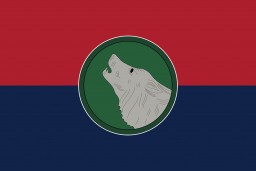
-
Flag graphic for US 10th Armored Division
PhotoA digital representation of the United States 10th Armored Division's flag. The US 10th Armored Division is also known as the "Tiger" division. During World War II, they captured the cities of Trier and Oberammergau. The division also overran a Dachau subcamp. The 10th Armored Division was recognized as a liberating unit in 1985 by the United States Army Center of Military History and the United States Holocaust Memorial Museum (USHMM).

-
Flag graphic for US 11th Armored Division
PhotoA digital representation of the United States 11th Armored Division's flag. The US 11th Armored Division (the "Thunderbolt" division) was formed in 1942. During World War II, they were involved in the Battle of the Bulge and captured the cities of Coburg, Bayreuth, and Linz. The division also overran the Mauthausen and Gusen concentration camps. The 11th Armored Division was recognized as a liberating unit in 1985 by the United States Army Center of Military History and the United States Holocaust…
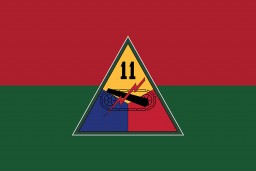
-
Flag graphic for US 12th Armored Division
PhotoA digital representation of the United States 12th Armored Division's flag. The US 12th Armored Divison is also known as the "Hellcats" division. During World War II, they captured the cities of Ludwigshafen and Würzburg. The division also overran a subcamp of Dachau. The 12th Armored Division was recognized as a liberating unit in 1988 by the United States Army Center of Military History and the United States Holocaust Memorial Museum (USHMM).
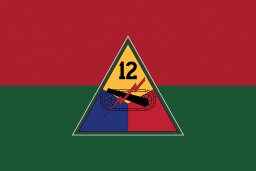
-
Flag graphic for US 14th Armored Division
PhotoA digital representation of the United States 14th Armored Division's flag. The US 14th Armored Division (the "Liberators" division) joined the war in 1944. During World War II, they uncovered several subcamps of Dachau, three large forced-labor camps, and several other nearby camps. The 14th Armored Division was recognized as a liberating unit in 1991 by the United States Army Center of Military History and the United States Holocaust Memorial Museum (USHMM).
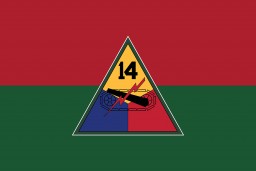
-
Flag graphic for US 26th Infantry Division
PhotoA digital representation of the United States 26th Infantry Division's flag. The US 26th Infantry Division (the "Yankee" division) was formed in 1917 and fought in World War I. During World War II, they were involved in the Battle of the Bulge and captured the city of Linz. The division also overran the Gusen concentration camp. The 26th Infantry Division was recognized as a liberating unit in 2002 by the United States Army Center of Military History and the United States Holocaust Memorial Museum…
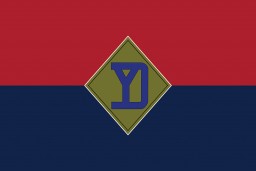
-
Flag graphic for US 29th Infantry Division
PhotoA digital representation of the United States 29th Infantry Division's flag. The US 29th Infantry Division (the "Blue and Gray" division) was established in 1917 and fought in World War I. During World War II, they were involved in D-Day, as well as the liberation of Dinslaken civilian labor camp. The 29th Infantry Division was recognized as a liberating unit in 1995 by the United States Army Center of Military History and the United States Holocaust Memorial Museum (USHMM).

-
Flag graphic for US 30th Infantry Division
PhotoA digital representation of the United States 30th Infantry Division's flag. The US 30th Infantry Division (the "Old Hickory" division) was established in 1917 and fought in World War I. During World War II, they were involved in the Battle of the Bulge and also liberated Weferlingen, a subcamp of Buchenwald. The 30th Infantry Division was recognized as a liberating unit in 2012 by the United States Army Center of Military History and the United States Holocaust Memorial Museum (USHMM).
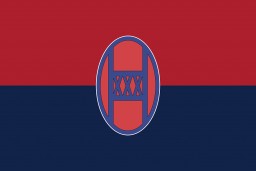
-
Flag graphic for US 36th Infantry Division
PhotoA digital representation of the United States 36th Infantry Division's flag. The US 36th Infantry Division (the "Texas" or "Lone Star" division) was established in 1917 and fought in World War I. During World War II, they were involved in the Allied invasions of North Africa and the Battle of the Bulge. The division also overran some of the Kaufering subcamps of the Dachau concentration camp. The 36th Infantry Division was recognized as a liberating unit in 1995 by the United States Army Center of…
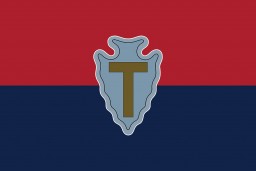
-
Flag graphic for US 3rd Armored Division
PhotoA digital representation of the United States 3rd Armored Division's flag. The US 3rd Armored Division (the "Spearhead" division) was established in 1941. During World War II, they were involved in the Battle of the Bulge and captured the city of Cologne. The division also discovered the Dora-Mittelbau concentration camp. The 3rd Armored Division was recognized as a liberating unit in 1985 by the United States Army Center of Military History and the United States Holocaust Memorial Museum (USHMM).
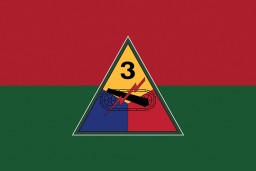
-
Flag graphic for US 42nd Infantry Division
PhotoA digital representation of the United States 42nd Infantry Division's flag. The US 42nd Infantry Division (the "Rainbow" division) was established in 1917 and fought in World War I. During World War II, they captured the cities of Würzburg, Schweinfurt, and Fürth. The division also entered the Dachau concentration camp. The 42nd Infantry Division was recognized as a liberating unit in 1985 by the United States Army Center of Military History and the United States Holocaust Memorial Museum…

